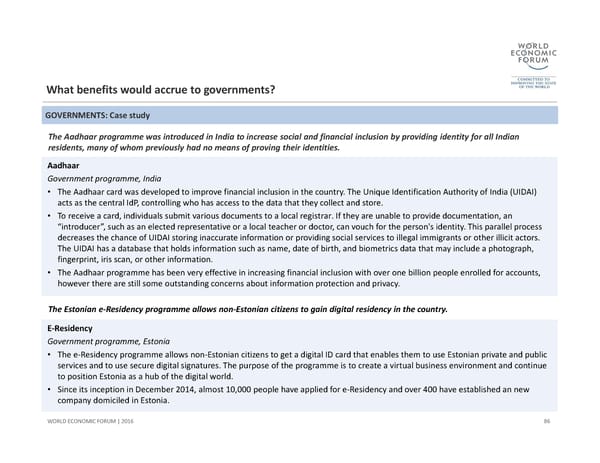Aadhaar Government programme, India •The Aadhaar card was developed to improve financial inclusion in the country. The Unique Identification Authority of India (UIDAI) acts as the central IdP, controlling who has access to the data that they collect and store. •To receive a card, individuals submit various documents to a local registrar. If they are unable to provide documentation, an “introducer”, such as an elected representative or a local teacher or doctor, can vouch for the person's identity. This parallel process decreases the chance of UIDAI storing inaccurate information or providing social services to illegal immigrants or other illicit actors. The UIDAI has a database that holds information such as name, date of birth, and biometrics data that may include a photograph, fingerprint, iris scan, or other information. •The Aadhaar programme has been very effective in increasing financial inclusion with over one billion people enrolled for accounts, however there are still some outstanding concerns about information protection and privacy. 86 WORLD ECONOMIC FORUM | 2016 GOVERNMENTS: Case study What benefits would accrue to governments?The Aadhaar programme was introduced in India to increase social and financial inclusion by providing identity for all Indian residents, many of whom previously had no means of proving their identities.E‐Residency Government programme, Estonia •The e‐Residency programme allows non‐Estonian citizens to get a digital ID card that enables them to use Estonian private and public services and to use secure digital signatures. The purpose of the programme is to create a virtual business environment and continue to position Estonia as a hub of the digital world. •Since its inception in December 2014, almost 10,000 people have applied for e‐Residency and over 400 have established an new company domiciled in Estonia. The Estonian e‐Residency programme allows non‐Estonian citizens to gain digital residency in the country.
 A Blueprint for Digital Identity Page 86 Page 88
A Blueprint for Digital Identity Page 86 Page 88